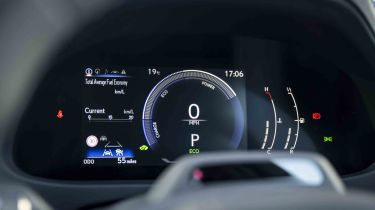Lexus UX - MPG, CO2 and running costs
The hybrid Lexus UX will be an affordable car to run; depreciation for the electric version is alarming

| Model | MPG | CO2 | Insurance group |
| UX 300h 2.0 Hybrid Urban | 56.4mpg | 113g/km | 24E |
| UX 300h 2.0 Hybrid E-Four Premium Plus | 50.4mpg | 126g/km | 27E |
The Lexus UX 300h is called a self-charging hybrid, which means you never need to connect it to a charging point, with electricity for the battery being generated during braking. The flip side is that you shouldn’t expect the same high levels of fuel efficiency a plug-in hybrid like the BMW X1 xDrive 25e promises, as the realistic all-electric range of the 300h is limited to just a couple of miles.
Official WLTP fuel economy figures are 56.4mpg for front-wheel-drive UX models, and 50.4mpg for four-wheel-drive ones.
As for emissions, Lexus claims that two-wheel-drive models will emit between 113-119g/km of CO2, while all-wheel-drive versions will produce 126-129g/km.
Electric range, battery life and charge time
| Model | Battery size | Range | Insurance group |
| UX 300e | 72.8kWh (64kWh useable) | 279 miles | 38E |
Lexus claims the current UX 300e's 72.8kWh battery pack (64kWh of which is usable) can provide a range of up to 279 miles. That’s reasonable compared with a BMW iX1, but significantly less than the over 300 miles of range you’ll get from a Genesis GV60.
You should also bear in mind for longer trips that the UX 300e’s maximum charging speed is a rather poor 50kW, which is subpar compared with its rivals, including the BMW iX1, which can accept a charging rate of 128kW, or even the GV60, which can charge at a rate of 233kW. This means a typical 10 to 80 per cent top-up will take over an hour in the 300e, which is especially annoying given that most rapid chargers have a 60-minute time limit before you incur an additional fee.
Used - available now
What’s more, the 300e uses the similarly outdated CHAdeMO charger, not the more widely used CCS charging connector you’ll find in almost every other new EV today – including the brand’s other EV, the Lexus RZ. While there are still plenty of chargers with this connector, it isn’t as common as CCS, so that might make route planning with the 300e trickier.
Most owners will probably end up charging their 300e with a standard 7kW home wallbox, which will take around 11.5 hours to fully replenish the battery.
The battery pack in the UX 300e is covered by a separate eight-year, 100,000-mile warranty covering the battery pack, which guarantees it won’t degrade below 70 per cent of initial capacity. Provided you always get the car serviced at a Lexus Centre, this warranty can be extended up to 10 years or 600,000 miles.
Tax
Despite having relatively low CO2 figures compared with a traditional petrol or diesel car, the hybrid 300h won't be overly attractive to company car drivers, due to the UX's 28-30 per cent benefit-in-kind tax rate. However, the electric 300e will cost significantly less in Benefit-in-Kind (BiK) tax payments because it is in the two per cent bracket, at least until 2025.
The electric version will also avoid being charged for annual VED payments, or being subject to the London congestion, although that’ll change for both from 2025.
You’ll need to avoid trims above F Sport Design Tech with the UX hybrid in order to keep the list price under the £40,000 threshold; otherwise, you’ll have to pay an additional annual surcharge applied from the second time the vehicle is taxed until it is six years old.
Insurance groups
A long list of active and passive standard safety features helps contribute to the reasonable insurance rankings of the hybrid UX, which starts in group 22E for the entry-level Urban version and rises to 32E for the priciest F Sport Takumi E-Four. That compares well with the BMW X1, which starts a couple of groups higher in 24E.
The electric 300e doesn’t do quite so well in 38E. Those looking for a more affordable premium electric small SUV ought to look towards the entry-level eDrive 20 BMW iX1, which starts in group 29E.
Check if your car needs an MoT and view its complete history with our MoT History Checker...
Depreciation
The entry front-wheel-drive Urban trim UX model is the strongest performer in terms of residual values, keeping around 50 per cent of its value over a typical three-year/36,000-mile ownership period. In comparison, the expensive priciest F Sport Takumi E-Four four-wheel drive version will only retain 39 per cent over the same period. For comparison, the BMW X1 retains its value better, maintaining between 49 - 55 per cent of its resale value.
Unfortunately, the electric 300e has the combined issues of being both the most expensive UX, and the version that loses the most value. Our expert data predicts the priciest Takumi trim will only hold on to 32 per cent of its value, which is especially painful when it costs over £57,000. Even the more affordable £47,500 base version will keep just 34 per cent of its value over the same period, which is why we suggest you look at the BMW iX1 instead, because that maintains between 46 - 51 per cent of its value over the same period.
To get an accurate valuation on a specific model check out our valuation tool...












